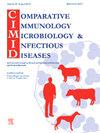Spatiotemporal analysis of the bovine brucellosis vaccination rate in Minas Gerais, Brazil, from 2011 to 2022
IF 2
3区 农林科学
Q4 IMMUNOLOGY
Comparative Immunology Microbiology and Infectious Diseases
Pub Date : 2025-06-25
DOI:10.1016/j.cimid.2025.102371
引用次数: 0
Abstract
The aim was to perform a spatiotemporal analysis of bovine brucellosis vaccination rate (BBVR) in Minas Gerais, Brazil, from 2011–2022 and to identify sociodemographic characteristics of cattle farmers associated with BBVR. A spatiotemporal analysis by means of a spatial autocorrelation test (Moran’s I test) and local spatial autocorrelation analysis (LISA) was conducted with the BBVR. A generalized linear mixed model (GLMM) was developed to investigate the influence of sociodemographic of cattle farmers on the BBVR from the agricultural census of 2017. The BBVR in Minas Gerais increased over time, and Moran’s I test revealed clusters of vaccination rates for all analyzed years, with low-high and high-high clusters becoming more prominent over the years. The GLMM revealed a positive influence of technical assistance, disease and parasite control, and sex on the BBVR. Therefore, our results elucidate the improvement of BBVR, indicating sociodemographic characteristics and regions that should be considered for tailored brucellosis control measures.
2011 - 2022年巴西米纳斯吉拉斯州牛布鲁氏菌病疫苗接种率时空分析
目的是对2011-2022年巴西米纳斯吉拉斯州牛布鲁氏菌病疫苗接种率(BBVR)进行时空分析,并确定与BBVR相关的牛农的社会人口学特征。采用空间自相关检验(Moran’s I检验)和局部空间自相关分析(LISA)对BBVR进行了时空分析。采用广义线性混合模型(GLMM)研究了2017年农业人口普查数据中养牛户社会人口学对BBVR的影响。米纳斯吉拉斯州的BBVR随着时间的推移而增加,Moran的I测试揭示了所有分析年份的疫苗接种率集群,低-高和高-高集群多年来变得更加突出。GLMM揭示了技术援助、疾病和寄生虫控制以及性别对BBVR的积极影响。因此,我们的研究结果阐明了BBVR的改善,表明了应该考虑定制布鲁氏菌病控制措施的社会人口特征和地区。
本文章由计算机程序翻译,如有差异,请以英文原文为准。
求助全文
约1分钟内获得全文
求助全文
来源期刊
CiteScore
4.60
自引率
0.00%
发文量
102
审稿时长
40 days
期刊介绍:
Comparative Immunology, Microbiology & Infectious Diseases aims to respond to the concept of "One Medicine" and to provide a venue for scientific exchange. Based on the concept of "Comparative Medicine" interdisciplinary cooperation between specialists in human and animal medicine is of mutual interest and benefit. Therefore, there is need to combine the respective interest of physicians, veterinarians and other health professionals for comparative studies relevant to either human or animal medicine .
The journal is open to subjects of common interest related to the immunology, immunopathology, microbiology, parasitology and epidemiology of human and animal infectious diseases, especially zoonotic infections, and animal models of human infectious diseases. The role of environmental factors in disease emergence is emphasized. CIMID is mainly focusing on applied veterinary and human medicine rather than on fundamental experimental research.

 求助内容:
求助内容: 应助结果提醒方式:
应助结果提醒方式:


